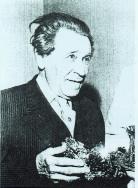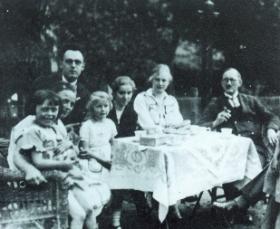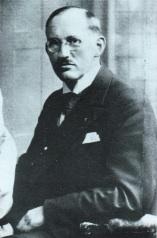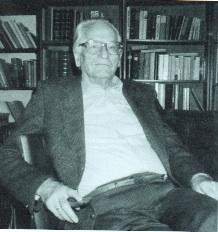The Nazis in Irish universities
Published in 20th-century / Contemporary History, Issue 5 (Sep/Oct 2007), News, Volume 15
Friedrich Herkner was appointed professor of sculpture at Dublin’s National College of Art in 1938. He was the only Nazi on the Irish state payroll to be re-hired after the war, resuming his old job until retirement in 1969.
It all came about as Europe flirted with fascism in the pre-war years. Hitler came to power in Germany in 1933, and another fascist leader, Benito Mussolini, had held power in Italy since 1922. In the 1930s both these leaders—together with Salazar in Portugal, Franco in Spain and Petain in France—wielded immense power and influence as continental Europe lurched towards the Second World War. Ireland had its fascist group—the Blueshirts, led by Eoin O’Duffy—while in Britain Sir Oswald Mosley’s Blackshirts, the British Union of Fascists, held the right-wing banner high.
Following Hitler’s takeover in January 1933, all state organs came under the umbrella of the National Socialist and German Workers’ Party (NSDAP), or Nazi Party for short. One such government agency was the German Academic Exchange Service, which still exists today under its German acronym DAAD. DAAD’s representative in 1930s Dublin was a German student named Helmut Clissmann, who had joined the Nazi Party on 1 May 1934. Ironically, given the May Day date of joining the NSDAP, Clissmann had started out as a member of the left-wing socialist Prussian Youth League. Under the control of the Nazis, the German Academic Exchange Service sought to send German undergraduates and lecturers all over Europe, while students and lecturers from other countries visited Germany, normally for an academic year.
Approximately twenty Irish students availed of the exchange system, which was funded by the Nazi administration in Berlin. For their part, most German students heading for Ireland were obliged to join the NSDAP in order to avail of funding for their visit, which comprised a return boat ticket plus a generous subsistence allowance to live on while pursuing their studies here.
The Germans studied at a number of Irish colleges, including UCC, UCD and Trinity. One of the UCG students was Hilde Poepping, who spent the

1937–8 academic year in Galway studying Irish literature. She joined the Nazi Party on 20 September 1937. During the war she worked at the German Foreign Office in Berlin and later at the Irish service of Berlin Radio, reading news bulletins in English. In the post-war years, Dr Hilde Spickernagel (her married name) was a secondary school principal in Berlin.
Another exchange student, Hans Hartmann, studied the Irish language at UCD’s Department of Folklore in Earlsfort Terrace. He stayed much longer than other German students, remaining in Dublin from 1937 to 1939. Apart from dressing up as Santa Claus for the German community’s annual Christmas party in the Gresham Hotel, Hartmann’s main interest was in mastering the Irish language. To this end, he studied different dialects in Connemara and Donegal. Hartmann had joined the Nazi Party on 1 March 1933, in his own words ‘in order to be left alone later on’. During the war he taught Celtic Studies in Berlin University, and was appointed head of the Irish service of German Radio in December 1941. Reasonably proficient in Irish, Hartmann broadcast Nazi propaganda to Irish listeners from 1941 until the end of the war in May 1945. His team of broadcasters included the writer Francis Stuart, whom Clissmann had fixed up with a job as an exchange lecturer in Berlin. The German Foreign Office official effectively in charge of the radio propaganda service to neutral Ireland was Dr Adolf Mahr, an Austrian Nazi on leave of absence from his job as director of the National Museum in Dublin.

Professor Ludwig Muhlhausen ran the Department of Celtic Studies at Berlin University and did the first Irish-language broadcasts from Nazi Germany, 1939–41. He later worked with an SS unit in Brittany.
In the 1960s Dr Hans Hartmann returned to Ireland and teamed up with UCD’s professor of Modern Irish, Tomás de Bhaldraithe, to undertake numerous tape-recordings of Irish-speakers in the Gaeltacht.
According to records in the US national archives, Trinity College in Dublin had by far the greatest number of German exchange students in the 1930s. They were (study dates): Gertrude Berger (dates unknown), Helmut Clissmann (1933–6, also worked as a lecturer in German), Hermann Martin Plass (1937–8), Susanna Milcke (1937–8), Friedrich Merkel (1938–9), Christian von Marwych (1938–9), Nona Keitel (1935–6), Irmgard Kundingen (1938–9), Heinz Rohr (January–August 1939), Fraulein Grimm (dates unknown), Herr Hoffmann (1934, exchange lecturer), Joseph ‘Jupp’ Hoven (dates unknown) and Einhart Kawerau *(dates unknown, exchange lecturer).
Nona Keitel’s father was commander-in-chief of the German army. The following is a brief account of her visit to the opera in Berlin in the mid-1930s, by a retired American journalist:
‘During the Nazi apogee, I had seen a Staatsoper performance that did not take place on its stage. Between acts, as our opera party slowly strolled ’round the grand foyer, a door from one of the boxes opened and the occupants emerged. The first one was Fraulein Nona Kettle, daughter of the commander in chief of the Wehrmacht, Colonel-General Wilhelm Keitel. Nona, a graduate of Dublin’s Trinity College, was a handsome young woman, six foot three inches tall. Following her out of the box were her escorts, three young officers, each of them six four or better. It revealed one of the advantages of being well-connected.’
Of course, Nona Keitel never graduated from Trinity, and neither did any of the other exchange students, who only attended the university for one academic year. Hans Hartmann did stay for two and a half years at UCD but did not take a degree there. Hartmann, who also spoke fluent Russian, was a graduate of Berlin University, where he later took a doctorate under the tutelage of Professor Ludwig Muhlhausen, who also did Irish-language broadcasts from Berlin from 1939 to 1941. Muhlhausen later worked with an SS unit in occupied Brittany, fostering links with Breton nationalists who sought independence from France.
There were a few other German Nazis teaching in Ireland in the 1930s. Franz Born worked as a professor of music, based in Carlow. He joined the NSDAP on 1 June 1937. In 1939 Dr Robert Stumpf, a radiologist at Dublin’s Baggot Street Hospital (who joined the Nazis on 1 January 1934), organised a trip to the Fatherland for a group of Irish doctors, which included the city’s chief medical officer, Dr Harbison. Professor Friedrich Herkner taught sculpture at the National College of Art in Dublin. He joined the Nazi Party on 1 September 1939, just before leaving Ireland to fight for Germany in the war. After the war he worked in Germany and Austria restoring statues that had been damaged by bombs. Herkner managed to get his job back at the College of Art in the late 1940s and retired in the 1960s. But not everyone was welcomed back. In 1946 de Valera’s government blocked the return of Adolf Mahr as director of the National Museum in Dublin. He was pensioned off and died in Germany in 1951.

Hans Hartmann, who joined the Nazi Party in 1933, studied Irish at UCD’s Department of Folklore from 1937 to 1939. He ran Berlin Radio’s Irish service from November 1941 to May 1945.
David O’Donoghue is the author of Hitler’s Irish voices: the story of German Radio’s wartime Irish service (Belfast, 1998), and The Irish Army in the Congo 1960–1964: the far battalions (Dublin, 2005).
*It should be noted that in 2013 History Ireland received a letter from the family of Kawerau Einhart correcting the unintended impression that he was a Nazi-sponsored exchange student. The full text of the letter can be read by clicking here.
















